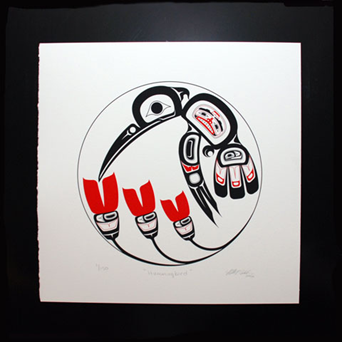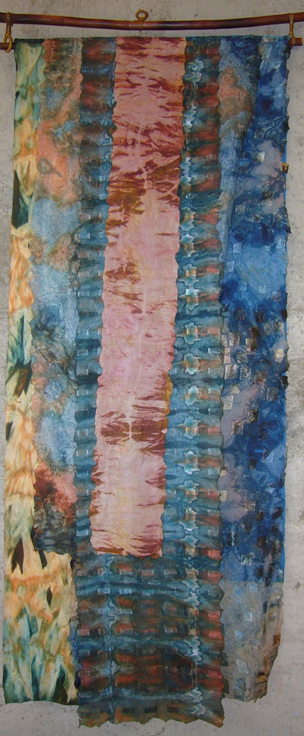5.1: Reading- Making Art on the West Coast
- Page ID
- 104416
Before You Read
Working with a partner or by yourself, answer the following questions.
1. Do you enjoy art? What kind of art do you like?
________________________________________________________________________
________________________________________________________________________
2. Can you remember a piece of art you made (either at school or in your free time)? Describe it. What inspired you to create this piece?
_______________________________________________________________________
________________________________________________________________________
The Reading
This reading profiles two artists who are strongly influenced by the west coast, its culture, and its environment. Read the article and answer the questions that follow.
Nathaniel P. Wilkerson
1 Nathaniel P. Wilkerson’s education and work have taken him to the USA and Japan, but his artwork is never far from his roots. Nathan is a painter and woodcarver who traces his Indigenous ancestry through the Gitxsan Nation, his mother’s family coming from the Hazelton/Kispiox area. He grew up on his family’s vegetable farm in Terrace, and while he now works as an engineer in Seattle, the traditions of northern British Columbia are still a strong influence on his art.
2 Nathan’s exposure to art came first from two teachers at elementary school, whose skills inspired him. He later received lessons in painting and woodcarving from Haida artist Freda Diesing; this was at the insistence of his mother, who wanted him to be properly schooled in the arts of his own people. He learned the basic rules and concepts of Indigenous art, and he learned the characteristics of the animals commonly found in the art of the northwest: wolf, eagle, bear, beaver, hawk, and raven.
3 Freda Diesing remains a key influence on Nathan’s work, as do Haida artist Robert Davidson and Tsimshian artist David A. Boxley. While he has dabbled in landscape painting and he admires the art of Japan, where he spent two years, Nathan’s work remains firmly rooted in his traditional background. He says, “I prefer a more classical approach in my artwork with heavier form lines and a look that is a combination of Gitxsan, Haida, and Tshimshian influences. I am always studying and trying to emulate the great masters of the past and present but at the same time offering my own creative interpretations.”

4 His own creative interpretations include experimentation with colour. He will often create a piece in the traditional style and colours, then make a version with a different colour scheme. He also relies on technology to bring perfection to his work. As he explains, art is constantly evolving, and part of that evolution includes the use of computer technology. The artist still needs to come up with the concept for the piece, but the use of computers can both speed up the production process and help the artist to achieve clear, crisp lines, such as those seen in Wasco and Hummingbird.
5 For Indigenous people, art is more than a form of recreation; as Nathan points out, it plays a vital role in the preservation of First Nations culture. His mother’s first language was Gitxsan, and she did not speak English until she was five. He can speak some Gitxsan, but he is by no means fluent; his five children speak even less. Language is dying, but art can be more easily kept alive. He has given lessons in traditional art at his children’s school, and he has two daughters who enjoy art, and who incorporate some of his shapes and lines into their own work. In this age of video games, he encourages children to become involved in art. “It’s good for them,” he says.

Nathaniel P. Wilkerson’s website is http://www.wilkersonart.com/.
6 Art, however, is not only a means of preserving culture. For First Nations people, it is also a way to affirm their identity. The 20th century was a difficult time for First Nations people, and feelings of shame were not uncommon. Nathan has a powerful statement on his website about the status of First Nations people in Canada, ending with “We must return to honour and become a self-sufficient, strong people, with our identity, lands and sovereignty restored.” In the 21st century, Nathan says, “We need to have our self-esteem returned.”
7 Art can play a role in creating a strong sense of cultural identity, and Nathaniel P. Wilkerson is playing a part in restoring a feeling of pride to his people.
Joanna Rogers
8 After ten years in Vancouver, artist Joanna Rogers was looking for a rural environment, and she happened upon Pender Island almost by chance. Eighteen years later, she is still there; she says, “I was inspired to create art here.”
9 The Pender Island environment is key to Joanna’s creativity. As she explains, “I take my dog for two long walks each day, either through the forests or along the beaches. I use this time to observe and also to mull over ideas for creating new work. I am inspired by the physical landscape around me; the narrow tree-lined trails, the craggy cliffs and other rock formations, the trees themselves and the lichens that grow on them, the kelp and driftwood on the beaches. I am also inspired by the play of light on the ocean and lakes at different times of year and times of day and in different weather.”
10 Joanna’s art epitomizes the mixed media genre. She is eager to point out that making art does not need to cost a lot of money. In her work, she uses feathers, leaves, kelp and shells collected from the beaches and forests on Pender Island. She has also used bottle caps, pennies, empty glass vials, photographs, bubble wrap, teabag packets and other kinds of household detritus; she has even incorporated her own hair in her art. She is often inspired by abandoned objects she finds lying around that “cry out to be incorporated in a piece of art.” The traditional textile techniques that Joanna uses in her work preserve the culture and importance of handwork. She weaves by hand, sews by hand, embroiders, and uses blocks to print. Many of the tools and techniques she uses have not changed in hundreds of years.

11 For Joanna, making art starts with an idea that she wants to explore. She builds on the initial idea, adding more layers of meaning and significance. One example is her piece entitled In Memorium or the Wake of Progress. As Joanna explains, “I started by thinking how I had lots of cassette tapes lying around that I no longer listened to.” She first tried knitting and embroidering with the tape, but she eventually decided to weave a suit of armour. This was based on an exhibit she had seen in the Museum of Anthropology at UBC of a suit of armour woven by the Kiribati people of Micronesia, made out of coconut fibre and embroidered with human hair. This piece was chosen as one of 49 finalists at the Salt Spring National Art Prize show.
12 Joanna believes art can also tell stories, and these stories will tell us about the creator of the piece and their family, community and history. The telling of these stories is often what keeps a culture alive and enables it to be passed on to new generations. Her Tumbling Cube Cope tells the sad tale of the British Columbia salmon fishery. Copes were worn by priests and kings in medieval times and are a symbol of power. The Tumbling Cube block is a traditional quilting pattern. The bubble wrap used resembles fish skin. The cubes resemble dice, and dice can be used to gamble. Joanna’s message is that various governments have gambled with the salmon stocks, sacrificing the fish for personal gain.
13 Influenced by her surroundings, Joanna Rogers is making powerful statements through her art.

Joanna Rogers’ website is https://joannarogers.ca/
Questions
A. Check Your Understanding
Answer the following questions.
- How did Nathan come to study with well-known artist Freda Diesing? What did he learn from the experience?
________________________________________________________________________
________________________________________________________________________
- How has modern technology helped Nathan in the creation of his art?
________________________________________________________________________
________________________________________________________________________
- How is Nathan helping to keep the traditional arts alive among young people?
________________________________________________________________________
________________________________________________________________________
- Give two reasons why Nathan says art is so important to Indigenous peoples.
a) ______________________________________________________________________
b) ______________________________________________________________________
- How does Joanna’s environment influence her art?
________________________________________________________________________
________________________________________________________________________
- What kinds of items does Joanna use in her art? What do these items have in common?
________________________________________________________________________
_______________________________________________________________________
- What did Joanna do with her old cassette tapes? What inspired her in this creation?
________________________________________________________________________
________________________________________________________________________
- Give an example of how Joanna uses art to tell a story.
________________________________________________________________________
________________________________________________________________________
B. Develop Your Vocabulary
Use each of the following words to complete the sentences below. Each word can only be used once.
exposure emulate evolution incorporate affirm
self-sufficient sovereignty mull over epitomize detritus
1. When you _________________________ something, you think about it over a period of time.
2. To _________________________ is to make a strong statement of belief in something.
3. If you are given _________________________ to something, you are made aware of it.
4. To _________________________ something means to include it in your own work.
5. People who are _________________________ are independent and need no support from others.
6. _________________________ is everyday garbage that is left behind after an event.
7. When you _________________________ someone, you admire that person and try to do something as well as they do.
8. _________________________ is the power or authority to govern a place.
9. _________________________ is the natural development of something over a period of time.
10. Art that _________________________s a particular style is an excellent example of that style.
C. Think about It
Think about the following questions. Write your thoughts, or discuss your ideas with your class.
- Nathan and Joanna are both highly motivated artists. What motivates each of them? What other reasons could people have to produce art?
________________________________________________________________________
________________________________________________________________________
________________________________________________________________________
- Are you a member of a First Nations community? If so, do you consider art an important part of your heritage? If not, are you interested in First Nations art? Explain your answer.
________________________________________________________________________
________________________________________________________________________
________________________________________________________________________
- Which other art forms might be valuable in keeping cultures alive? Think about music, dance, and other forms of expression. Use examples from your own experiences.
________________________________________________________________________
________________________________________________________________________
________________________________________________________________________
- Nathan uses computer technology to create his art, while Joanna uses techniques that are hundreds of years old. How would each artist explain their own approach? Whose approach do you most agree with?
________________________________________________________________________
________________________________________________________________________
________________________________________________________________________
- Have the readings about Nathan and/or Joanna changed your opinion of art, or have they inspired you to create your own art?
________________________________________________________________________
________________________________________________________________________
________________________________________________________________________
- What question(s) would you like to ask either Nathan or Joanna?
________________________________________________________________________
________________________________________________________________________
________________________________________________________________________
D. Go Further
Find an art exhibition in your community, or visit a store selling works of art. Find a piece that you particularly like. Answer the following questions.
- What is the name of the piece?
- Who is the artist?
- What is shown in the work of art? Is it realistic, abstract, or a combination of the two?
- What can you find out about the artist? Where is he or she from? What are his or her influences? How does the artist’s work reflect his or her background?
- Why do you particularly like this piece? What does it say to you?
Write notes about your chosen piece of art in the space below. Share your information with your class.
________________________________________________________________________
________________________________________________________________________
________________________________________________________________________
________________________________________________________________________
________________________________________________________________________
________________________________________________________________________
________________________________________________________________________
________________________________________________________________________
________________________________________________________________________
________________________________________________________________________

